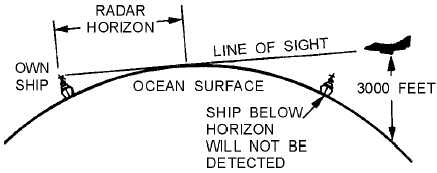1-10
ANTENNA HEIGHT AND SPEED.—Another factor affecting radar range is antenna height. The
high-frequency energy transmitted by a radar system travels in a straight line and does not normally bend
to conform to the curvature of the earth. Because of this, the height of both the antenna and the target are
factors in detection range. The distance to the horizon (in nautical miles) for a radar system varies with
the height of the antenna according to the following formula:
For example, assume antenna height to be 64 feet in the following calculations:
A target at a range greater than the radar horizon will not be detected unless it is high enough to be
above the horizon. An example of the antenna- and target-height relationship is shown in figure 1-7.
Figure 1-7.—Radar horizon.
The antenna-rotation rate also affects maximum detection range. The slower an antenna rotates, the
greater the detection range of a radar system. When the antenna is rotated at 10 revolutions per minute
(rpm), the beam of energy strikes each target for just one-half the time it would if the rotation were 5 rpm.









